Exotic in your beds - white cucumbers: varieties, cultivation features and differences from green
White cucumbers look unusual both in the garden and on the dining table. If you love trying something new, this vegetable crop will delight you with exotic fruits. These plants grow well in different climatic conditions and have strong immunity, which greatly facilitates care. If you adhere to simple agrotechnical rules, then even a beginner can cope with the cultivation of white cucumbers.
The content of the article
Are there white cucumbers
Varieties and hybrids of white cucumbers were bred by breeders in several countries, so they differ among themselves. White cucumbers have been cultivated in Russia for many years.
Their distinctive features
White cucumbers have a number of differences from their green "counterparts":
- white vegetables never taste bitter;
- the shell is thin and delicate;
- light cucumbers have a rich taste and fresh aroma;
- the culture easily tolerates temperature fluctuations;
- the bushes grow and bear fruit normally even at a temperature of + 45 ° C;
- plants tolerate partial shade well;
- in dense foliage, white fruits are immediately visible;
- in the greenhouse, fruiting lasts until frost;
- the fruits are tied along the entire length of the whip, so white varieties give high yields.
These varieties of cucumbers suitable for growing summer residents who do not have the opportunity to regularly water and harvest.
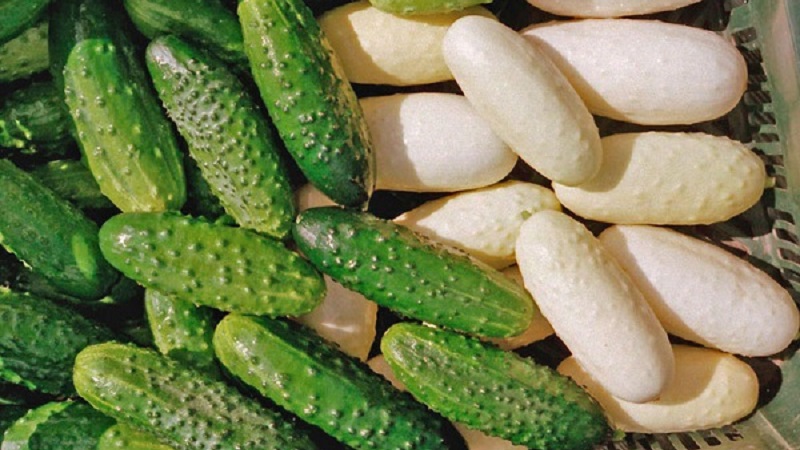
The photo shows a comparison of white and green cucumbers.
Advantages and disadvantages of white cucumbers
Positive qualities of white varieties:
- plants tolerate temperature changes well;
- bushes have powerful stems;
- strong immunity to diseases and pests;
- do not need shaping;
- the absence of pigment makes the vegetable safe for allergy sufferers;
- fruits contain a large amount of micronutrients;
- excellent keeping quality and transportability of cucumbers.
These varieties have few disadvantages:
- lashes grow well, so they definitely need a garter to the support;
- some varieties need more care.
White cucumbers have more positive qualities than disadvantages, which is why some vegetable growers prefer just such varieties.
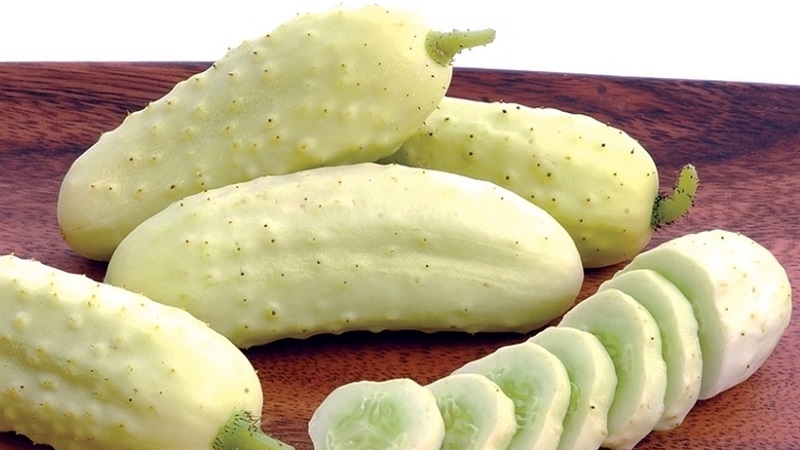
Popular varieties
There are not as many white varieties of cucumbers as there are green ones, but among them you can choose worthy ones for growing. They differ in such characteristics:
- suitable for open ground and greenhouse structures;
- the fruit has a spiky or smooth surface;
- long or the size of gherkins;
- used for summer salads and winter preparations;
- there are both parthenocarpic and bee-pollinated.
White cucumber varieties are not yet very popular in Russia, therefore they are not used on a large scale for sale on the market.
On a note. The yield of white varieties is on average 10-14 kg per 1 sq. m.
Snow White
High-yielding, early-maturing variety... Easily tolerates temperature fluctuations. The culture is grown in open ground and greenhouses.
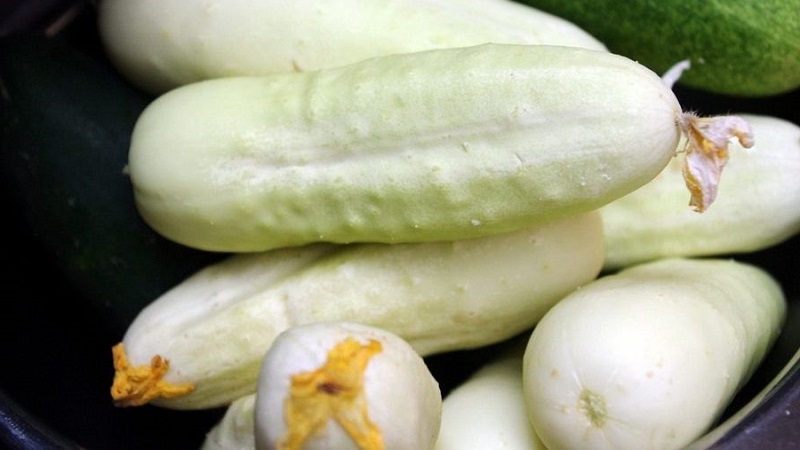
The peel is thin, the taste of vegetables is pleasant, slightly sweet. The color of the fruit is snow-white. The pulp is tender, the texture is soft. The seeds are small, there are few of them in cucumbers. The variety is very popular with farmers.
Snow White cucumbers are mainly grown for industrial purposes, for sale. Fruits are suitable for conservation and fresh consumption.
Italian white
Vegetables have a flat surface with few bumps... Fruit length - 20 cm. The flesh is soft, juicy and aromatic.
The plant is tall, therefore, it requires a mandatory garter to the support. Some grow crops horizontally. An unpretentious variety, has a high resistance to diseases.
White Angel f1
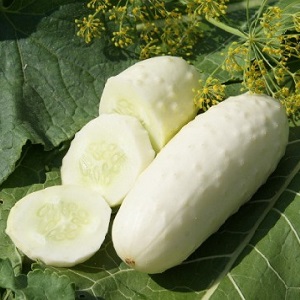 An early ripening hybrid. Vegetables reach technical maturity in 50-55 days... Mixed flowers. These cucumbers are cultivated both outdoors and indoors.
An early ripening hybrid. Vegetables reach technical maturity in 50-55 days... Mixed flowers. These cucumbers are cultivated both outdoors and indoors.
The mass of one fruit reaches 60-70 g, the length is 7-9 cm. There are small white thorns on the surface.
Vegetables do not have bitterness, but when they outgrow, they lose taste... Immunity to diseases is weak. Use White angel for preparing fresh salads and preserving. The yield reaches 12-15 kg per 1 sq. m or 4 kg per plant.
About other exotic cultures:
White delicacy
Mid-season variety was bred by Chinese breeders... The technical maturity of vegetables occurs 45-50 days after germination. The culture is grown in open ground and greenhouses.
Cucumbers are conical in shape. The length of lumpy fruits reaches 12-15 cm. The peel is tender and soft, does not have any bitterness. Up to 4 kg of harvest is harvested from one bush. Cucumbers are canned, pickled and consumed fresh. The culture has a strong immunity to disease.
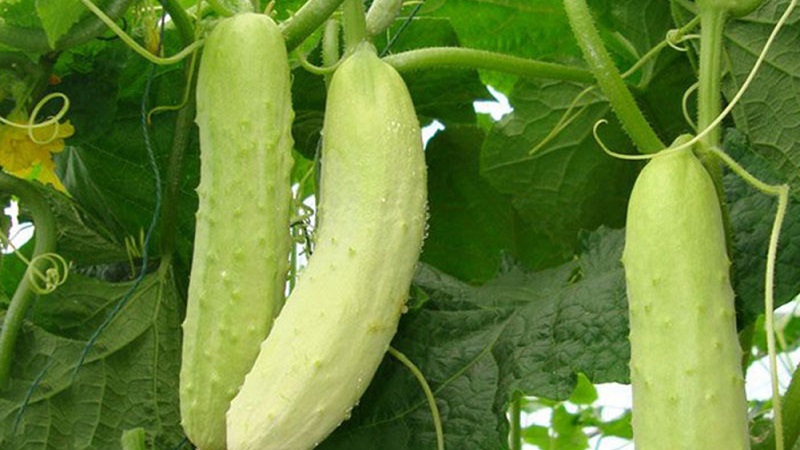
Snow Leopard
High-yielding variety. The maximum length of vegetables reaches 25 cm. The bush grows up to 3 m in height. As the culture grows, it is tied up or directed to special nets installed nearby. Vegetables can be removed when they reach 6-8 cm. Basically cucumbers of this variety are pickled or pickled.
Martini f1
Cucumbers have a yellowish tint with a green tint. Fruits are small, 8-14 cm long. The shape of vegetables is oval-elongated. There is no bitterness in the pulp, even if the cucumbers are overripe. The yield is high, from 1 sq. m harvest from 10 to 14 kg.
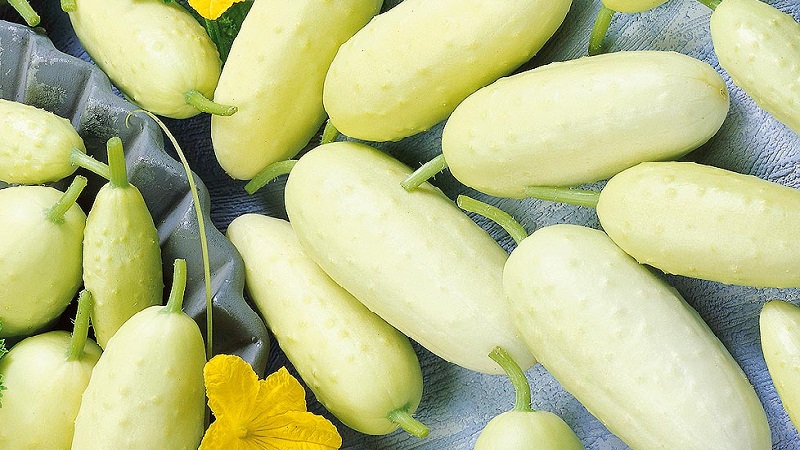
Bride
Early ripening variety, pollinated by insects... Vegetables ripen in about 40 days. The plant is tall. For 1 sq. m, no more than four bushes are grown and up to 20 kg of vegetables are harvested. The taste of the fruit is pleasant, slightly sweet. The pulp is tender. The variety needs frequent watering and responds well to organic fertilizing.
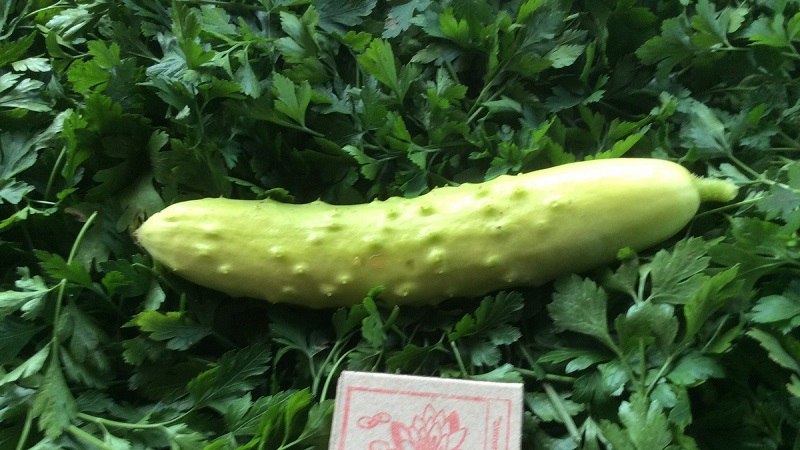
Bidigo-Lungo
Hybrid bred specifically for greenhouse cultivation... Thanks to this, the fruits are harvested until October-November. The variety is early maturing and high-yielding, bears fruit for a long time. The fruits ripen 50 days after planting in the greenhouse. They are mainly consumed fresh.
F1 white crunch
Hybrid mainly grown in greenhouse conditionsbut it is also suitable for outdoor use. It takes about 45 days from sowing to harvesting. The yield is high. Fruits without thorns, smooth, white peel.
Cucumbers are delicious, tender and aromatic. They reach 180 g in length, but it is better to harvest fruits up to 10 cm. Even overripe cucumbers are not watery, but they still lose their taste.
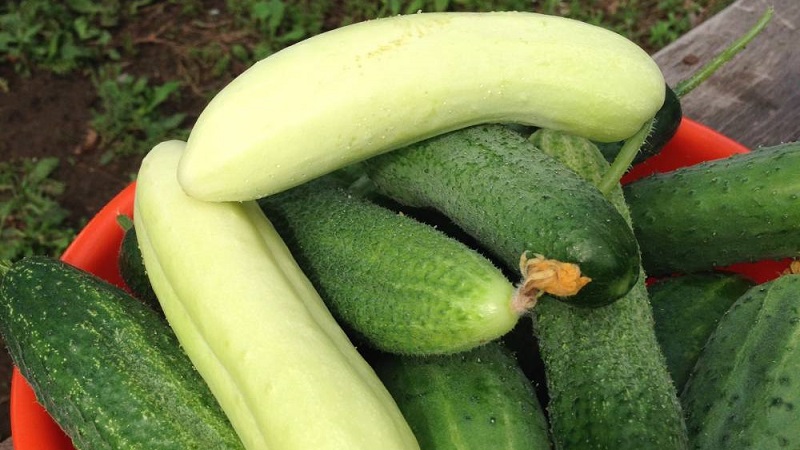
White sugar f1
This mid-season hybrid was bred by the Ural breeders. Fruits 8-12 cm long are creamy white. The crop is harvested 45-50 days after germination... Rarely tuberous fruits have a delicious taste and are versatile in use.
Scourges are not spreading, pinching and pinching are not required for them. The culture is grown both in open and closed ground.
For your information. Growing cucumbers on trellises will facilitate the care and picking of vegetables, save space on the site.
Growing features
Traditionally, white varieties and hybrids of cucumbers are cultivated both in greenhouses and in open field conditions. Planting is carried out with seeds or seedlings, the age of which reaches 25 days... The distance between the planting holes is about 15-20 cm.
After thinning, 2-4 plants are left per running meter, depending on the variety.The soil for planting cucumbers should be fertile, loose, have a slightly acidic or neutral reaction - pH = 6.5-7.
Additional application of wood ash or lime to the soil will serve as prevention from the development of fungal diseases. For a longer preservation of moisture and looseness of the soil, plantings are mulched.
Grown plants are tied up on a stretched net or vertical trellis. This provides them with optimal growing conditions - sunshine and fresh air, and also keeps vegetables clean.
Ovaries are formed both on the main and lateral shootsso they do not require shaping. But if desired, the growth point of the main stem is pinched, thereby stimulating the formation of lateral shoots and increasing the yield.
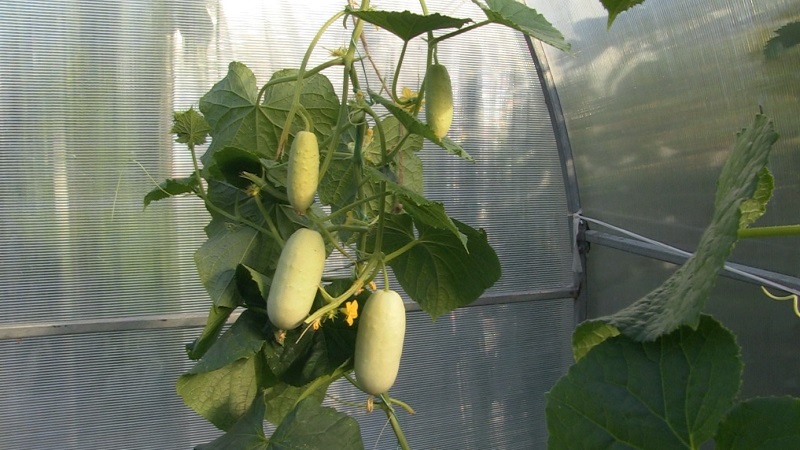
The rest white cucumbers need standard agricultural practices:
- loosening the soil;
- weed removal;
- watering;
- dressing with mineral fertilizers - for example, potassium sulfate, superphosphate or ammonium nitrate - 3-5 times during the entire growing season.
Organic fertilizers are also used as dressings., fermented infusions of mullein, chicken droppings or nettles.
Important! It is necessary to regularly weed the soil around the plants. Overgrown weeds create shade and take nutrients from the soil.
Unlike green cucumbers, white ones are less demanding on the frequency of watering.... They are abundantly moistened in the morning or in the evening with warm, settled water every 3-4 days. Watering in the middle of the day provokes leaf burns.
White cucumbers love high humidity. To do this, a container is dug into the ground next to the plants - for example, a barrel - and filled with water. During evaporation, the humidity of the air will increase, creating an optimal regime for the crop.
Cucumbers are cut when they reach a length of 10-15 cm - about twice a week... Most varieties and hybrids do not lose their taste during outgrowth. In greenhouses, white varieties bear fruit before frost.
Typical diseases and pests
The main feature of white cucumbers is their resistance to diseases and pests.... They are practically not affected by aphids, peronosporosis and other characteristic diseases.

According to the reviews of experienced gardeners, white cucumbers are not treated with anything when growing, but the rules of prevention against diseases and pests are observed:
- do not plant cucumbers close to each other;
- periodically remove weeds from the site;
- do not moisten plantings with cold water;
- fertilize regularly;
- after planting, young plants are treated with Bordeaux liquid.
If you follow these measures, you will not have to fight diseases.
The use of white cucumbers
White cucumbers are good for making summer salads and any kind of preparation... Small fruits are used for whole fruit canning.
Read also:
Reviews of summer residents
White cucumbers are actively grown in most regions of the country.... They are not afraid of cold weather and have a strong immunity to diseases and pests. For these and other advantages, vegetable growers rate white varieties positively.
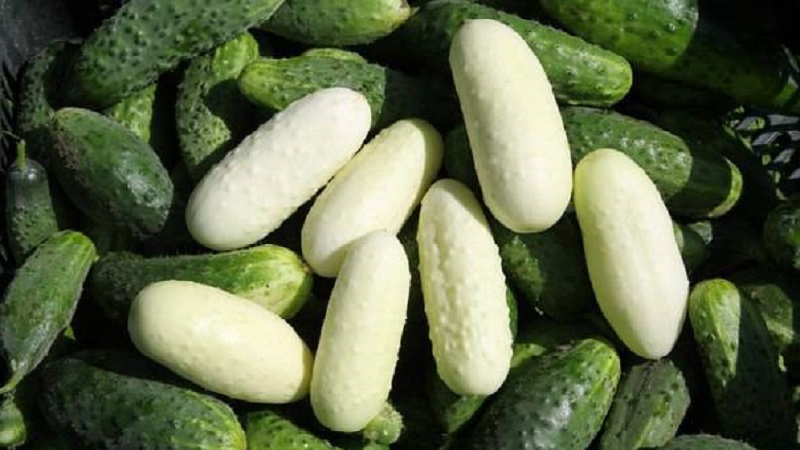
Marina, Voronezh: “I've been working on the garden for about 15 years. Last year I decided to try something new. I planted a cucumber variety White sugar f1. The vegetables ripened in about a month and a half. The plants did not hurt. The fruits are juicy, slightly sweet, and have a pleasant taste. I took pictures with gherkins and pickled them in jars. Also covered interspersed with green varieties. They look great. The whole family loved it. I advise everyone!".
Olga, Mtsensk: “I have been growing white cucumbers for 4 years in a row. They are really good for preservation. Vegetables remain firm, firm and crispy. Only overgrown fruits I do not use for this. They don't look good and the taste is not the same. Children love to eat fresh cucumbers, bitter ones never come across. The peel is thin, tender. Plants are unpretentious in care.I harvest in 1-2 days. I really liked the vegetables. I will continue to grow ".
Tatiana, Ryazan: “At the beginning of spring, my husband and I are planting a white cucumber variety Bidigo-Lungo in the greenhouse. Young vegetables are already growing in May. We take care of plants, as well as green varieties, but the yield and benefits are much higher. We use organic matter as fertilizer, mullein infusion. We do not use nitrogen products because we want the vegetables to be natural. Plants must be tied to a vertical support. We really like the look of the fruit. The culture is unpretentious in care and, unlike conventional varieties, is not afraid of the cold. ".
Conclusion
White cucumbers differ slightly from their green "counterparts": the taste, methods of application, cultivation and care are the same. The difference is only in color. Vegetables are cultivated in greenhouses, greenhouses, in the open field, from early spring to late autumn.
Outdoors, white varieties bear fruit until October. They are easy to grow and, with minimal maintenance, allow you to get an excellent harvest.